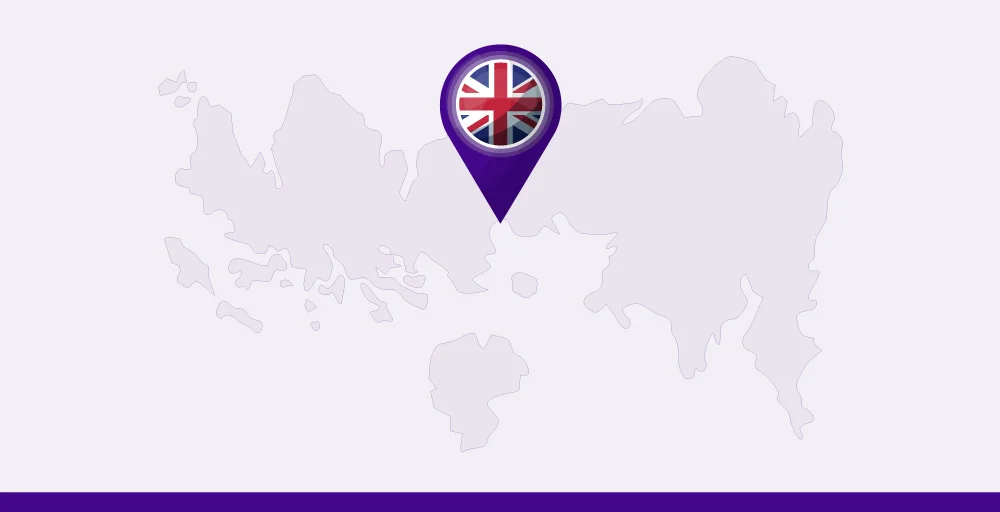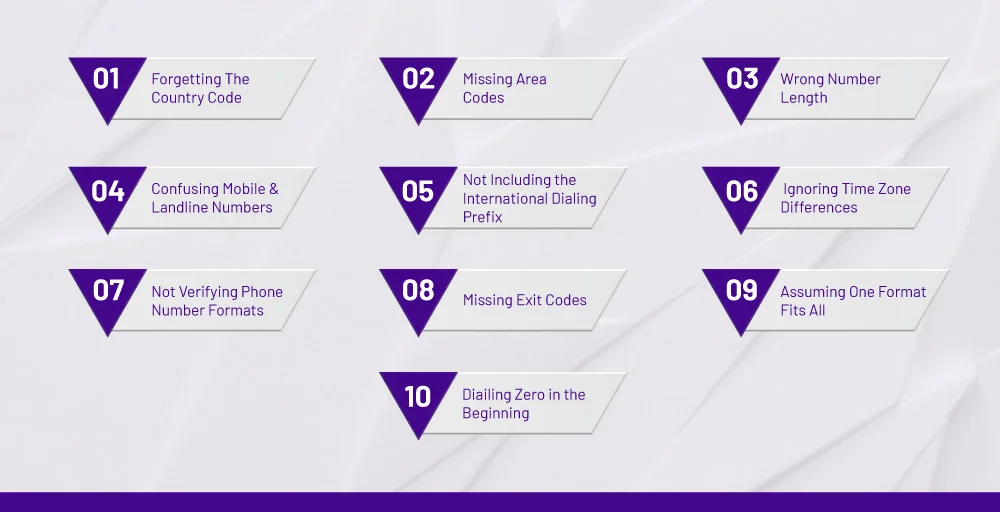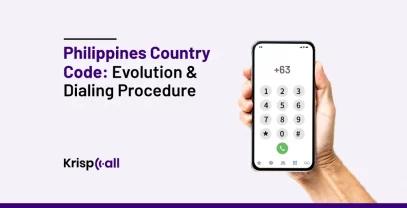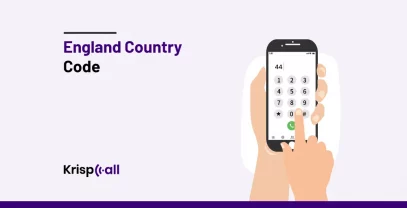Country codes are important when calling internationally because they tell your phone network where to direct the call. 📱
However, If you get the country code wrong, your call might be sent somewhere different than you intended! With country codes, one little slip-up could make a big difference in where the call actually goes.
Like every other country, the UK has its own country code, 44. If you don’t enter the 44 code when dialing to or from the UK, your call will not go through to the actual number.
In this blog, we’ll go over some common mistakes people make when using the UK country code so you can avoid getting mixed up with the formatting. Knowing these pitfalls can help save you time and frustration down the road.
🔑 KEY HIGHLIGHTS
- The UK country code is 44. Make sure to include this when dialing to or from the UK.
- Different areas in the UK have their own area codes as part of the full phone number.
- Mobile numbers in the UK start with 07, while landline numbers often start with 01 or 02.
- To make an international call outside the UK, dial 011 before the UK country code (44).
- Be mindful of the 5-6 hour time difference between the UK and other countries—don’t call late at night by mistake.
- To avoid common mistakes, double-check all details of the UK number, such as the country code, area code, and full number length, before dialing.
Understanding the UK Country Code

The UK has a country code that’s important to know when making phone calls there. The code is 44, so anytime you see a number starting with those two digits, it’s a UK phone number. Usually, a UK number will be written like +44 20 1234 5678 with the 44 first. UK mobile numbers also show the 44 country code, like 44 7521 345876.
Likewise, If you’re calling from another place like the US, dial 011 44 and then the rest of the UK number, with 011 as the international call code. You don’t need the 44 country code within the UK, but the code gets added when a call goes outside the country.
Moreover, The format of UK numbers after the country code can vary. Landlines usually begin with 01 for local calls, 02 for national calls, or 03 for mobile/non-geographic numbers. UK mobile numbers always start with 07. Knowing the standard UK number structures is good, so you don’t mix anything up. You must always include the 44 country code when dialing to or from the UK internationally so the caller knows where to route.
10 Common Pitfalls to Avoid When Using the UK Country Code

Understanding the UK country code is essential to dialing the number correctly. Here are 10 common pitfalls to avoid when using the UK country code:
Mistake #1: Forgetting The Country Code
When trying to call someone in the UK, messing up their phone number is easy. You have to remember a few things to get it right. First, don’t forget to include the country code since the UK has a different one than the US or other countries. The UK country code is 44, so all numbers there start with that. If you leave it out, the call won’t go through.
Other mistakes are switching up the order of numbers or adding extra digits where there aren’t supposed to be any. You have to be careful to get each number in the right spot. It can be confusing, but taking your time and double-checking that the country code and the rest of the number match will help prevent mix-ups that cause the person not to receive your call.
Mistake #2: Missing Area Codes
Another common error when calling numbers in the UK is forgetting to include the area code. Like in the US or other countries, different areas in the UK have their own codes, so the full number comprises the country code, area code, and subscriber number. The call won’t get routed correctly if you leave out the area code part.
Taking a close look at any UK numbers given and double-checking that the country code and the right area code are present can help avoid this type of mistake, in which the call doesn’t go through properly.
Mistake #3: Wrong Number Length
When trying to remember and dial a number from the UK, you have to be careful of the number of digits. UK numbers can be longer than other countries. If you don’t write the full number down or repeat it back correctly, it’s easy to get the length wrong.
For example, if the actual number is 020 1234 5678, but you think it’s shorter and only dial 020 1234 567 by mistake. Then the call won’t work right. Taking a second to repeat the whole number or double-checking what was given prevents getting the length messed up, which causes issues with getting the call to go through.
Mistake #4: Confusing Mobile and Landline Numbers
Another thing that can trip you up with UK phone numbers is not knowing if it’s a mobile or landline numbers. They can look similar at first glance but are different. Mobile phone numbers there start with 07, while landlines often begin with 01 or 02. It can lead to issues if you don’t pay close enough attention to which type of number was given.
For example, a landline number starts with 020, but you accidentally dial it as a mobile by putting 07 in front instead. The call won’t go through properly because you mixed up the kinds. It’s important to understand whether it’s a cell phone or a regular home phone so you can start dialing with the right prefix and not get confused.
Mistake #5: Not Including the International Dialing Prefix
Another mistake that can happen when you’re trying to ring someone in another country, like calling a UK number from the US, is forgetting to use the code to make it an international call. From America, you have to dial 011 first before entering the country code.
So, for a UK number, it’d be 011 44, followed by the rest. But if you dial the country code and number without the 011, it won’t connect right since your call won’t be sent internationally. That’s why you always double-check that you have the proper dialing info to prevent a mix-up.
👍 Related How To Call The United Kingdom From The US
Mistake #6: Ignoring Time Zone Differences
Another mistake with UK numbers is not realizing the time difference. The UK is 5 hours ahead of the US. So if you forget about that and call someone over there at 8 PM thinking it’s an early evening for them too, it may be super late already!
It’s important to do the math on the time difference so you’re not bugging people when it’s the middle of the night for them. That way, your communication will happen during their normal hours and not upset them by disturbing their sleep without realizing it.
Mistake #7: Not Verifying Phone Number Formats
If you don’t double-check the format, it’s easy to make a mistake with UK phone numbers. You should always verify the first few digits when someone gives you their number. For example, if it starts with 01 or 02, it’s a landline number. But if the number begins with 07, it’s a cell phone.
If the format doesn’t look right when someone tells you it, be sure to ask them to repeat just the first part so you have it correct. That way, when you go to call, you’ll dial the right kind of number. Taking a second to make sure the format is right helps you avoid calling the wrong type of phone or missing a number because you didn’t notice a mistake. Verifying the format before calling saves you from potential problems.
Mistake #8: Missing Exit Codes
Another mistake that can happen when you’re ringing up someone in the UK from a different country, like United States of America, is forgetting to include the exit code. The exit code lets the call leave your network and go to their network abroad. So, from the US, before dialing the UK country code of 44, you need that 011, which is the US’s exit code, so your call connects to the UK.
If you just dialed the 44 without the 011, your call probably wouldn’t go through because the phone doesn’t know where to direct it. You have to put in that exit code, or else your network might not connect you properly to the UK number. It’s easy to overlook but important to remember, or else the person won’t receive your call.
Mistake #9: Assuming One Format Fits All
When dialing a number in the UK, thinking they will all follow the same pattern is wrong. Just because one number starts with a specific code doesn’t mean another number will be in precisely the same format. UK numbers can be landlines that begin with 01 or 02 or mobiles with 07. But there are also other non-standard numbers that pop up! So don’t assume the next one given will automatically match what you’ve seen before.
It’s wise to listen closely each time to catch the actual code and not rely on a past format. Otherwise, you might blunder dialing it if you copy the wrong format from memory. Taking the extra two seconds to double-check how a new number is structured prevents errors from guessing instead of confirming what you heard.
Mistake #10: Diailing Zero in the Beginning
When copying down or dialing UK phone numbers, it’s essential to dial that first zero if there is one. Whether it’s a landline starting with 01 or 02 or a mobile beginning with 07, losing that initial zero could cause problems. If you wrote it down missing the zero, then tried calling or sending it as a text without that extra digit, the number wouldn’t go through right.
Phones recognize the leading zero, designating it as a UK number. Without it, your call may not get routed across correctly, or the person on the other end might not receive your message. It’s an easy mistake if you’re not paying attention, so keep those leading zeros intact when handling UK numbers.
Best Practices for Using the UK Country Code
Making calls to the UK is a great way to stay connected with others. Here are the best practices to follow while using the UK country code so that your calls get connected:
Understanding Dialing Methods
There are a few different ways you may need to dial when using the UK country code, depending on where the call is originating from. You don’t need to include the 44 code if calling from within the UK. But, if you’re calling from anywhere else internationally, you’ll need to add the exit code of the country you’re calling from (e.g., 011 for US and Canada) before the 44. The 011 signals your network to route the call overseas. Taking a few minutes to research the proper internal dialing methods for your location can save trouble down the road.
Consider Call Rates
Another important thing to consider with the UK country code is how much it might cost you to make calls. If you’re dialing from outside the UK, international call rates can get pretty expensive depending on your cell phone plan. So, before dialing the number, take a minute to check what your carrier charges per minute to the UK. Being aware of rates can help you choose the most cost-effective way to get in touch.
Be Mindful of Time Differences
Another thing to remember with the UK country code is that there is a time difference depending on where you’re calling from. If you’re dialing a UK number from the US, there is a 5-hour gap. So, you wouldn’t want to call someone late at night because of the time difference. It’s a common mistake if you don’t stop to check what time it is for the other party. Therefore, a quick Google search can be beneficial before the call button.
Test Voice Quality
When making calls internationally using the UK country code, you’ll want to check how clear the voice quality is before jumping into a long, important call. Sometimes, connection issues can pop up when the call travels far between countries. So, do a test call with somebody in the UK first to see if the voice quality is fine. That way, if there is interference or an echo, you know ahead of time rather than halfway through an important chat.
Uptime and Redundancy
When you need reliable contact numbers in the UK, it’s smart to have some backup options just in case your primary calling method doesn’t work. No technology works perfectly all the time, so setting yourself up with redundant systems prevents you from being stranded if one goes down. Make sure you have alternate programs, Wi-Fi connections, or mobile networks you can switch to instantly. This way, random outages won’t leave you high and dry when you desperately need to reach somebody overseas.
Conclusion
Following best practices is key to ensuring your calls to UK numbers go through without problems. Taking time to fully understand the UK country code format, international dialing methods, timing differences, and call quality will eliminate many common mistakes. Being aware of costs and having backup options also ensures your communication stays reliable.
Most importantly, go slowly and confirm all the details when dialing a UK number. Don’t assume the format—always verify the leading digits. Double-checking may take an extra minute but will save a lot of hassle from incorrect calls. Using the techniques covered here trains you to dial UK contacts with confidence and prevents headaches down the road.




